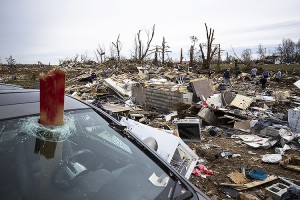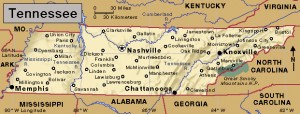Tennessee’s Deadly Tornadoes
March 18, 2020
Earlier this month, on the night of March 2-3, massive thunderstorms spawned a cluster of tornadoes in Tennessee, killing 25 people and causing widespread destruction. The two most powerful tornadoes struck Nashville, the state capital, and nearby Putnam and Wilson counties. Tornadoes from the same storm system also touched the neighboring states of Alabama, Kentucky, and Missouri. Tennessee’s tornado outbreak was the worst since a group of more than 50 tornadoes killed 35 people in the state in April 2011.

Storm debris litters Putnam County, Tennessee, on March 4, 2020, a day after a tornado ravaged the area. credit: Brett Carlsen/Getty Images
Thunderstorms grew in size and intensity over Tennessee on March 2, and tornadoes were reported in eastern and northern parts of the state. Just after midnight, an EF3 strength twister hit downtown Nashville (in Davidson County) and quickly tracked eastward more than 60 miles (100 kilometers) into Wilson County. EF stands for the Enhanced Fujita scale, used to rate the strength of tornadoes. The scale rates tornadoes from 0, the weakest, to 5, the strongest. EF3 tornadoes have winds between 136 and 165 miles per hour (218 and 266 kilometers per hour) and can tear away roofs and walls from houses and overturn cars. An even stronger EF4 tornado—with winds up to 200 miles per hour (322 kilometers per hour)—then hit nearby Putnam County, but spared most of Cookeville, the county’s largest town. Of the 25 deaths from the Tennessee tornadoes, 18 of them occurred in Putnam County. Hundreds of people were injured in the storms, and numerous buildings were destroyed.

Tornadoes struck Nashville and nearby ares of central Tennessee on the night of March 2-3, 2020. credit: World Book map
In the days after the storms, Tennessee Governor Bill Lee declared a state of emergency, and the Federal Emergency Management Agency (FEMA) provided millions of dollars in assistance to the hardest-hit areas. Schools, public offices, and interstate highways were closed for days in the region, and tens of thousands of people were without electric power.


